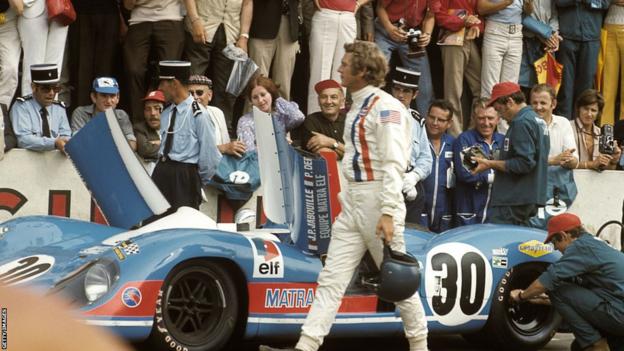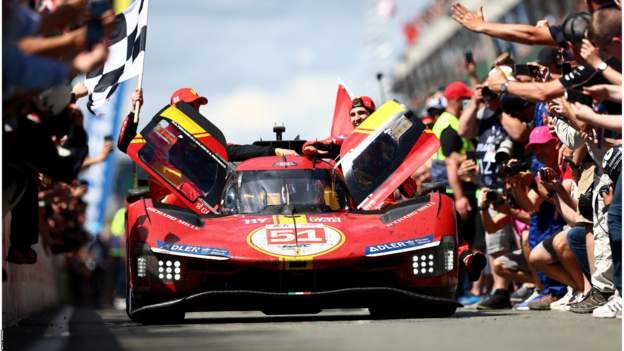[ad_1]


Engine overrun – a sound created when droplets of gas escape on to red-hot exhaust pipes.
Typically it appears like thunder. Typically a robotic exploding. Typically like an enormous tree snapping in half. Sometimes, in case you’re shut sufficient, it rattles your rib cage.
Curiously, it does not register on tv protection, however it’s loud. Very loud.
It’s a part of motorsport’s majesty. Whether or not it’s a part of its future, although, is one other factor.
The sound of gas frying on metallic appears to many to be more and more out of step with a warming world, wherein local weather consciousness is rising with the mercury.

At Le Mans, engine overrun drowns out a backing monitor of thumping home music, fireworks and drunken roars.
About 300,000 folks flock to north-west France for this annual Glastonbury for petrolheads, with the toughest core accumulating across the Dunlop Curve to observe the motion.
The headline act, as ever, is the 24 Hours of Le Mans race. Over the course of a day and night time, three-strong driver groups battle fatigue and the sphere to steer their aggressive prototype racing machine in direction of one of many greatest prizes in motorsport.
This yr marks 100 years because the race’s first staging. For some time, although, it appeared prone to limp previous the landmark.
With the prohibitive prices of competitors and the race’s old-school picture apparently out of time, Toyota had been the one top-level producer competing in recent times, successfully racing themselves.

The glory days, epitomised by the 1971 movie Le Mans – wherein actor Steve McQueen broods and Porsches and Ferraris battle beneath banners promoting oil and cigarettes – appeared gone for good.
The organisers confronted a dilemma: learn how to faucet a wealthy previous whereas making the race related as soon as once more.
The reply lay within the rule guide.
“These new laws allow automobile producers to have freedom of design and now we now have incredible automobiles,” says World Endurance Championship CEO Frederic Lequien.
“It is a return to the historical past of Ferrari competing towards Peugeot, Porsche and Cadillac. We’ve the perfect automobile producers on this planet. By no means in historical past has endurance racing been so brilliant.”
Looser restrictions have given rise to hypercars – lovely evolutions of sportscars of the previous, with every firm free to comply with a philosophy and area statement-making fashions, one thing that’s far more durable to do in Components 1 and Components E, the place largely identikit automobiles fill the grid.
Lining up for this yr’s season are a modern Porsche, Common Motors’ Cadillac, which appears like a muscle automobile on steroids, and Peugeot’s masterpiece, the 9X8 – a rear wing-less, childhood dream of a design.
However this revival – which noticed the race offered out two weeks after happening sale – is led by Ferrari, who’ve returned to Le Mans after 50 years away, including to their already exhaustive F1 schedule.
“We’re very, very busy, however very completely happy,” says Antonello Coletta, Ferrari’s head of GT sport. “We come again to the top of endurance in crucial class – hypercar – with much less time in respect to the opposite opponents, however we’re tremendous completely happy.
“Le Mans is crucial race on this planet.”
Coletta is a part of a brand new mould of Ferrari leaders. Gone are the Gucci socks and blazers. He displays a extra business-like method, and you’ll hear it in his phrases.
He says that many elements of the 499P – which, like all good Ferraris, is gorgeous, however laborious to handle – are being examined to be used on highway automobiles.
Crucial element is not a part of the 499P’s sweeping bodywork, nevertheless. It’s hidden away, deep within the engine. And it’s the innovation, perhaps greater than some other, that’s essential for Le Mans’ future.

At this yr’s race all 62 automobiles, together with the various privateer entries, run on a sustainable gas comprised of winery grape pores and skin waste.
The wine business’s residue is reworked into ethanol, then transformed into useable gas. Its makers say it reduces carbon dioxide emissions by 65%.
It’s a very French resolution to a world downside.
F1’s improvements are inclined to take longer to reach on the highway, however their route of journey is identical.
Like Le Mans, F1 is eager to point out there may be an alternative choice to electrical automobiles, and has promised to run on its own 100% sustainable fuel for 2026.
For the second, although, Le Mans is probably the most highly effective instance but for producers as they advocate for a variety of how to gas the long run.
Mixed with Ferrari’s super-efficient engine, which makes use of far much less gas for simply as a lot energy, there’s a fashionable, extra frugal face for a storied race.
Might the current for Le Mans even be the long run for the person on the street?
Definitely a few of the arguments put ahead by the race’s supporters seem like having an impact.
The European Union (EU) is reportedly near amending a proposed plan to outlaw the sale of all new combustion-powered automobiles by 2035. As an alternative of electric-only automobiles, it apparently intends to permit the manufacture of latest fashions that run off carbon-neutral fuel.
The potential transfer has been criticised by environmental groups, who argue that carbon-neutral fuels are unproven, costly to supply and a expensive distraction from the best path to decarbonising highway transport.
“I do not need anybody to assume we’re anti-electric. Removed from it,” says F1 technical head Pat Symonds, who’s spending his seventieth birthday visiting Le Mans for the primary time.
“In an city atmosphere an electrical car is an excellent resolution to many issues.
“However, equally, in different arenas and different territories an electrical car is not the right reply.
“Within the race to cut back carbon emissions and sort out world warming – one thing pricey to my coronary heart, consider me – too many governments all over the world say, ‘right here is resolution we would like you to undertake’ and engineers say ‘OK, it is a good resolution however not the one resolution’.
“We have seen this transformation just lately since February within the EU, which is resulting in them recognising the worth of sustainable fuels, and I believe we’ll see that worldwide.”

Within the thick forest subsequent to the well-known Mulsanne straight at Le Mans, you’ll be able to hear the distant drone of the engines held within the tall timber. It is a dream-like expertise at night time, a relentless churn of brilliant headlights and uncooked sound.
Within the oppressive warmth of a Le Mans summer time day, the mushy moss saps power from the air.
Mulsanne has been sanitised since Ferrari final raced right here as a works staff – two chicanes gradual the tempo to assist scale back the possibility of a automobile dropping its downforce load and, as they’ve prior to now, taking off like an aeroplane and touchdown within the timber.
It’s 10 years because the race noticed its most up-to-date fatality when Dane Allan Simonsen crashed his Aston Martin on the nook previous Mulsanne, Tertre Rouge. His automobile hit a tree behind the barrier, simply minutes into the race.
“On each driver’s licence it says motorsport is harmful,” Ferrari’s James Calado muses within the staff’s big hospitality suite.
“We realise the hazard, however in all honesty the chance is not excessive in case you examine it to bikes on the Isle of Man. It isn’t even 0.1% of the hazard of what these boys are doing.
“Sometimes unhealthy accidents can occur – usually fluke. I do not wish to jinx it, however automobiles are tremendous secure – you’ll be able to have a big effect and the automobile will probably be totally intact.”
Motorsport has cleaned up its security document since Le Mans’ dirty glory days. Given sustainable fuels nonetheless launch particulates similar to poisonous nitrogen dioxide and electrical automobiles take in energy from the grid, there’s a approach to go earlier than the identical may be stated for its sustainability credentials.
“As a driver my job is to drive the automobile and do the perfect I can,” says Calado.
“I am all for sustainability. It is tough to know what is going on to occur sooner or later. The entire world must make a distinction and we’ll do all the pieces we will to assist.”
Calado, Britain’s most high-profile manufacturing unit Ferrari driver since Nigel Mansell within the late Eighties, acknowledges the facility that Le Mans has as a stage, each for a race and, probably, for greater questions that have an effect on us all.
“It’s magical,” he provides with a smile when speaking about driving in the midst of the night time. “The followers by no means go away… it is three or 4 in morning and you’ll nonetheless see and scent the barbecues if you end up within the automobile.
“You scent all the pieces – the sparks when a automobile scrapes the bottom, and we get mud in our eyes the place the visor’s open.”
It is an elemental expertise. Drained drivers really feel the aches, style the filth and scent the fumes.
For Calado and Ferrari, the weekend additionally completed with the sight of the chequered flag and a landmark victory to cap off the marque’s comeback to Le Mans.
And the signature sound, for higher or worse, remained the identical as ever – the crackle of engine overrun.
[ad_2]

